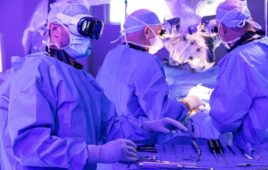 Researchers from Johns Hopkins University developed a coating made from antibiotic-releasing nanofibers to prevent bacterial infections related to total joint replacement surgery.
Researchers from Johns Hopkins University developed a coating made from antibiotic-releasing nanofibers to prevent bacterial infections related to total joint replacement surgery.
The work was published this week in Proceedings of the National Academy of Science. Although the team used rodents’ knee joints to demonstrate the effects of the nanofiber film, they suggest that the coating could have “broad applicability” in orthopedic prostheses, pacemakers, stents and other implantable devices.
“We can potentially coat any metallic implant that we put into patients, from prosthetic joints, rods, screws and plates to pacemakers, implantable defibrillators and dental hardware,” co-senior study author Dr. Lloyd S. Miller said in prepared remarks.
Conventional antibiotic delivery is usually limited to 1 antibiotic at a time and it’s challenging to control the release rate of the drug. For 3 years, the Johns Hopkins team worked on a developing a thin, biodegradable plastic coating that could release multiple antibiotics at controllable rates. The coating is made of a nanofiber mesh, embedded within a thin film. The mesh and the film are made of polymers that are used for degradable sutures.
The team loaded the nanofiber coating with a pair of antibiotics including rifampin, and vancomycin, daptomycin or linezolid. “Rifampin has excellent anti-biofilm activity but cannot be used alone because bacteria would rapidly develop resistance,” Miller explained. The coatings released raifampin for 3 to 5 days, and 1 of the other 3 antibiotics for 7 to 14 days. “We were able to deploy 2 antibiotics against potential infection while ensuring rifampin was never present as a single agent.”
They used each combination of antibiotics to coat a type of pin used in orthopedic surgery to fix bones in place after a wrist fracture. They inserted these wires into the knee joints of mice and introduced a bacterium that commonly causes biofilm-associated infections following orthopedic surgeries. The engineered-bacteria gave off light, which allowed the team to monitor the infection non-invasively.
After 14 days of infection, none of the mice that received pins with either the linezolid-rifampin or daptomycin-rifampin coating had detectable bacteria on the implants or in the surrounding tissues. Mice that received a coating with antibiotics had abundant bacteria in the tissue around the knee joint and 80% had bacteria on the implant.
“We were able to completely eradicate infection with this coating,” Miller said. “Most other approaches only decrease the number of bacteria but don’t generally or reliably prevent infections.”
After the 2 weeks were up, researchers removed the rodents’ joints and saw that bone loss often seen near infected joints was also prevented in the animals that received pins with the antibiotic-loaded coating.




